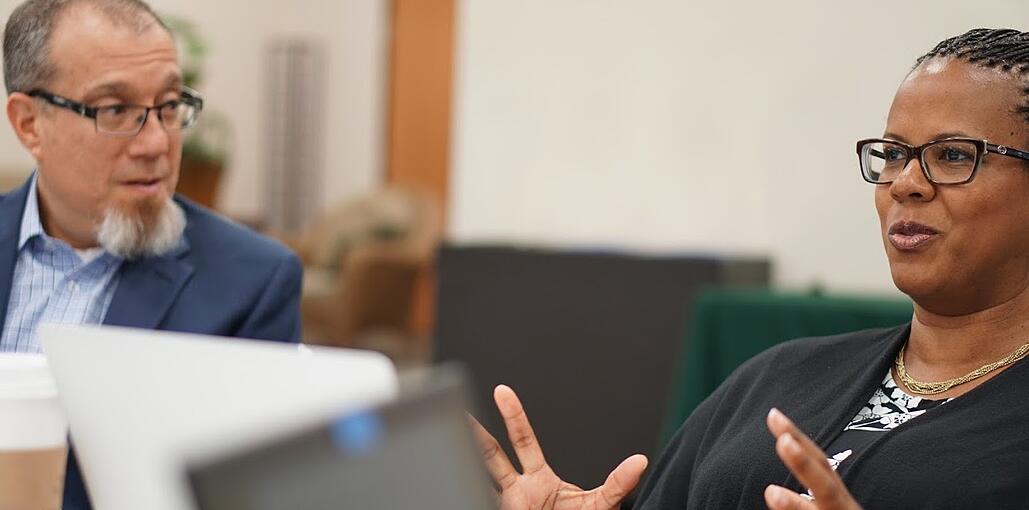
“I did then what I knew how to do. Now that I know better, I do better.”
– Maya Angelou
I have a confession to make: I didn’t get into education because I was excited to be a teacher. I went into education because I was eager to work for change in communities, and I believed that working with young people was the best way to do that. Lucky for me, I also happened to really enjoy teaching. Ultimately, teaching was my way of working toward social justice.
In order to do that, I always chose to work in schools and school districts that were labeled as “struggling.” While I saw and connected with the tremendous assets in these communities, I also felt that I was there to help and be of service. A second confession: Almost 30 years ago, when I started teaching, I believed these communities needed help — and that if I, an informed and educated individual, could help, it was my duty to do so.
“I’m encouraging my team — and they’re encouraging me — to listen more and talk less.”
I wish I could share with young Max what I’m now learning about being and working in community with others.
I’d want him to know that he isn’t aware of how deeply woven racism is into the fabric of how we educate children in the United States. And how his perception is narrowed by design — part of the privilege afforded to him as a white male.
I’d turn his attention from “helping” to identifying and surfacing the systems that have prevented — and continue to prevent — Black and brown students from excelling and exceeding.
And I’d implore him to name and fight racist acts and policies.
This reckoning with my younger self forces — and empowers — me to reflect deeply. However inadvertently, by defining myself as a “helpful white educator,” I started my career perpetuating the myth of the “white savior” and further reinforcing white supremacy in the classroom.
“What role can I, as the leader of CEL, play to further educational justice today?”
To quote Maya Angelou, “I did then what I knew how to do.” But what does, “Now that I know better, I do better” look like? As the leader of CEL, what role can I play to advance educational justice today?
Of this I am certain: as an organization, CEL needs to evolve. I now know that our role is less about our expertise and our help, and more about listening — so the communities we serve can better engage their existing strengths and assets as they lead.
Max reflects on what “to be behind or by somebody’s side” means. (58 seconds)
And our role needs to be either by somebody’s side or behind them. I’m certain that to get closer to educational justice, we must get closer to people whose views and experiences can shape our own; we must be by their side as they work to change beliefs, behaviors and policies.
I’m encouraging my team — and they’re encouraging me — to listen more and talk less. In the past year, we’ve strived to attain that balance by asking students what school experience they want.
What we’ve heard, loudly and clearly, across grade levels and demographics, is that students want a school experience that makes them feel “happy and proud.” Happy and proud. What a far cry from closing an achievement gap based on standardized test scores.
Why CEL asked students what school experience they want. (1:28)
To counter the impact of racism in American education, we are challenged to work differently — by centering student experience. Students will guide us toward equity, but only if we listen. Their message to educators and policymakers has been simple but powerful: take a more holistic, broad view of what impacts student experience inside and, just as importantly, outside the school’s four walls. That’s what will lead to all students thriving.
“What we heard, loudly and clearly, across grade levels and demographics, is that students want a school experience that makes them feel ‘happy and proud.'”
For our students to thrive, we must strive as leaders to refocus our leadership. To that end, I’m excited to introduce the revamped Four Dimensions of School LeadershipTM (previously Four Dimensions of Instructional Leadership). The name change reflects the shift in how we view leadership. We’ve changed the name to focus not only on what a leader does around instruction but around a bolder question: what evidence exists that community members feel a sense of belonging, significance and agency? Together, that provocative question and the new 4DTM framework are meant to inspire, provoke and prompt leaders to ask different and more difficult questions about their leadership.
How the 4D framework inspires, provokes and prompts to lead differently. (1:15)
As the leader of CEL, I want us to not simply know better, but to do better. And while I don’t have all the answers, I’m certain that if we are going to do better, we must be allies and amplifiers of student voices. That, I believe, is what creating true change in communities looks like. That is how we can meaningfully support the work of leaders — and ultimately, that’s how we can approach the goal of creating limitless futures for all students.

